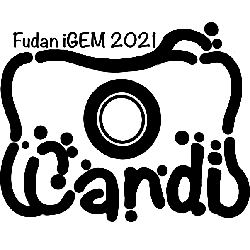Difference between revisions of "Part:BBa K3790150"
TiTong Fudan (Talk | contribs) (→Experimental Results) |
TiTong Fudan (Talk | contribs) (→Experimental Results) |
||
| Line 21: | Line 21: | ||
[[File:T--Fudan--DbpA-bst.jpg|600px|thumb|none| '''Figure 1. Assembled fusion proteins.''' The first lane was loaded with DNA ladder, sizes were marked on the image. The second lane (lane-1) was loaded with Bst-(G2S)3-DbpA DNA. The brightest band of 750 bp was about 100 ng, and other bands about 50 ng. Lanes with correct sized amplified DNA were labeled. After PCR cloning, several bacterial clones were picked, grew into cultures and sent for Sanger sequencing. Then, we verified the sequencing results, and used the correct ones for further experiments.]] | [[File:T--Fudan--DbpA-bst.jpg|600px|thumb|none| '''Figure 1. Assembled fusion proteins.''' The first lane was loaded with DNA ladder, sizes were marked on the image. The second lane (lane-1) was loaded with Bst-(G2S)3-DbpA DNA. The brightest band of 750 bp was about 100 ng, and other bands about 50 ng. Lanes with correct sized amplified DNA were labeled. After PCR cloning, several bacterial clones were picked, grew into cultures and sent for Sanger sequencing. Then, we verified the sequencing results, and used the correct ones for further experiments.]] | ||
| + | |||
| + | We have the pET backbone in our laboratory stocks (namely pET28). | ||
| + | |||
| + | We used ClonExpress® Homologous Recombination Kit from Vazyme to perform PCR based cloning, placing Bst (Figure 1) between [https://parts.igem.org/Part:BBa_K3790209 T7 RBS] and [https://parts.igem.org/Part:BBa_K395601 T7 terminator]. | ||
| + | Homology arm primers used are documented at the [https://parts.igem.org/Part:BBa_K3790212:Design Design] page | ||
After ClonExpress® homologous recombination reaction, Fast-T1 competent bacteria were transformed with reactants, and spread onto LB plates with ampicillin. We picked colony after 16 h culturing plates at 37℃. We further grow clones in 2 ml LB liquid medium with kanamycin, 37℃ shaking overnight. | After ClonExpress® homologous recombination reaction, Fast-T1 competent bacteria were transformed with reactants, and spread onto LB plates with ampicillin. We picked colony after 16 h culturing plates at 37℃. We further grow clones in 2 ml LB liquid medium with kanamycin, 37℃ shaking overnight. | ||
Revision as of 17:18, 21 October 2021
Bst-(G2S)3-DbpA
Introduction
The fusion protein obtained by linking the C-terminus of Bst Pol to the N-terminal of DbpA via a (G2S)3 linker
Usage and Biology
The fusion protein obtained by linking the C-terminus of Bst Pol to the N-terminal of DbpA via a (G2S)3 linker. Moreover, in our experimental expectation, the enzymatic activity of this fusion protein is increased compared to wild-type Bst Pol.
Experimental Results
The length of Bst-(G2S)3-DbpA DNA was 2013 bp, which is approximately 2020 bp after adding homology arms to both ends for PCR cloning. We isolated the DNA of interest by gel extraction for subsequent reactions.

We have the pET backbone in our laboratory stocks (namely pET28).
We used ClonExpress® Homologous Recombination Kit from Vazyme to perform PCR based cloning, placing Bst (Figure 1) between T7 RBS and T7 terminator. Homology arm primers used are documented at the Design page
After ClonExpress® homologous recombination reaction, Fast-T1 competent bacteria were transformed with reactants, and spread onto LB plates with ampicillin. We picked colony after 16 h culturing plates at 37℃. We further grow clones in 2 ml LB liquid medium with kanamycin, 37℃ shaking overnight.
Mini-prep was performed the following day, and the resulting plasmids were sent to Sanger sequencing, our synthesized DNA sequence was confirmed to be correct.
Reference
Sequence and Features
- 10COMPATIBLE WITH RFC[10]
- 12COMPATIBLE WITH RFC[12]
- 21COMPATIBLE WITH RFC[21]
- 23COMPATIBLE WITH RFC[23]
- 25COMPATIBLE WITH RFC[25]
- 1000COMPATIBLE WITH RFC[1000]

